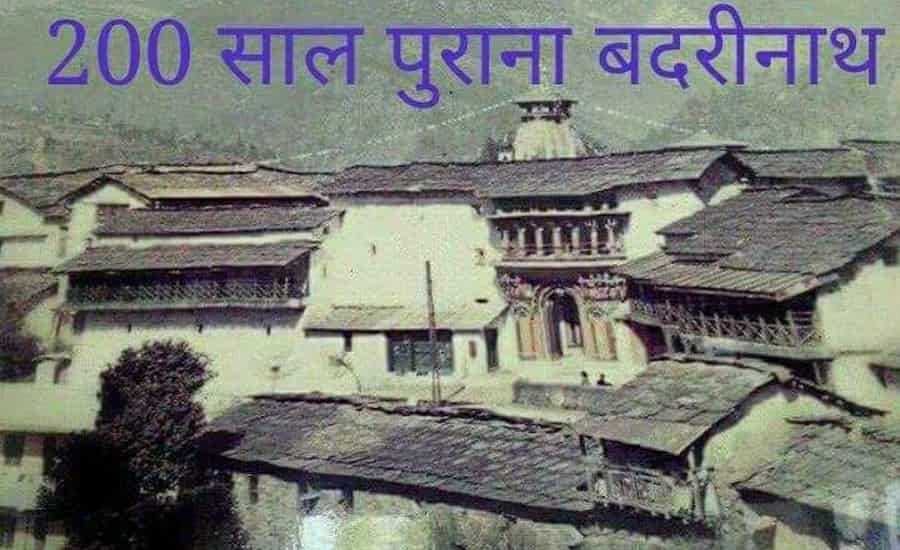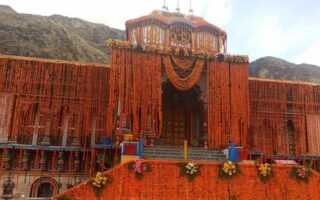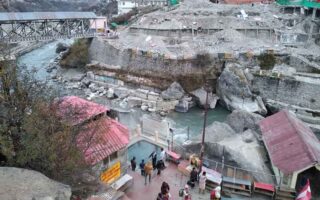Badrinath is the last on the Char Dham pilgrimage circuit, the abode of Lord Vishnu. The temple is located in Badrinath in Uttarakhand and it is one of the 108 Divya Desams of Vishnu. Located at a height of 3133 metres on the banks of the Alaknanda River in the Garhwal Hills in Chamoli district, the temple is accessible for six months in a year from April to November. Vishnu resides here in the form of a black stone statue and it is believed to be a self manifested form of the Lord.

Legends
According to legend Vishnu meditated here for millenia in the freezing cold and his consort, Lakshmi, turned herself into a Badri tree to give him shelter and protection against the elements. Therefore the lord is known as Badrinarayan. The reason for his performing austerities is that a sage saw Lakshmi massaging his feet and this mortified the Lord. He assumed the Padmasana pose and meditated for thousands of years.
The Vishnu Purana states that Nar and Narayan, sons of Dharam, searched the Himalayas to set up a hermitage and found the Panch Badris of which Badrinath is one, located next to hot and cold spring beside the Alaknanda. Apart from the Vishnu Purana, the temple is also mentioned in the Skanda Purana, Mahabharata and Bhagavata Purana. The Bhagavata Purana states that Vishnu reincarnated in the form of Nar and Narayana for the welfare of people. The Padma Purana describes Badrinath and its surroundings as being full of spiritual treasures. The holy mountain, Swargarohini, is located close to Badrinath. It is believed the Pandavas ascended to heaven from this mountain. Lord Krishna, addressing Arjuna, before the war, told him that he, Arjuna, was Nara in a previous birth and performed austerities at Badri. Badrinath is just one of the many manifestations of Lord Vishnu. Lord Krishna, Arjuna, Nar, Narayana and Vamana are a few of his many forms. The stepwell temple at Patan in Gujarat depicts the ten avatars of Lord Vishnu in intricately beautiful carvings.
Quaintly enough, Badrinath was once home to Lord Shiva and his consort, Goddess Parvati. Returning home after a walk they found a baby on their doorstep. Parvati wanted to pick up the child but the all knowing Lord Shiva knew the real truth and forbade her from touching the child. Parvati remonstrated and picked up the child. The put the child inside their home and went to take a bath in the hot water springs. On returning they found doors to their house locked so Shiva, who knew the truth, decided to shift their base to Kedarnath.
History
There are no written records of the Badrinath Temple. It is believed that Adi Shankaracharya visited this place during this travels all over India. He stayed here from 814 to 820 AD and found the idol of Lord Vishnu in the Alaknanda River. He then installed the idol in a cave close to Tapt Kund. One version states that the present Badrinath temple was a Buddhist temple and Shankaracharya had the Buddhist monks expelled with the help of Kanak Pal, a Parmar king of the region. The idol was then installed in the present Badrinath temple. Another version states that the King of Garhwal moved the idol to the present temple premises in the 16th century. The original temple was damaged in the Earthquake in 1803 and the temple was rebuilt by the King of Jaipur during the 1870s.
The present Badrinath temple has a traditional Garbha Griha that houses the idol of Lord Badrinath. Leading to this part is the Darshan Mandap where rituals are usually performed. This is preceded by the Sabha Mandap where devotees rest or sit while waiting their turn for the Darshan of the Lord.

